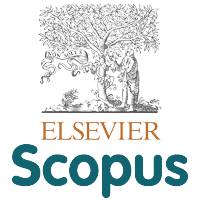Determining the Ideal Type of Superior Variety as A Target for Breeding of Winged Bean
Abstract
Breeding activities for winged bean plants (Psophocarpus tetragonolobus (L.) DC.) necessitate genetic diversity from local varieties. Identifying winged bean lines adds valuable initial information for shaping policies in plant breeding. Before proceeding with varietal development, it is crucial to establish the ideal type (ideotype) for superior winged bean varieties. The primary objective of this research is to ascertain the idiotype for superior winged bean varieties. The research was conducted in 2023 at Universitas Brawijaya, Indonesia, and involves the evaluation of five improved lines. The initial evaluation focuses on qualitative and quantitative characteristics of ideotype. The second evaluation concerns winged bean seeds' ideal morphological and physiological qualities. The third evaluation assesses winged bean pods' ideal physical and organoleptic preferences. The research outcomes have yielded the ideal morphological characteristics for winged bean varieties. This idiotype will be the foundation for the direction and target of winged bean plant breeding efforts, among the lines evaluated. NSM2 exhibits ideal flowering time and pod length characteristics, and lines PTL and PTL display ideal pod forms. MML and PBL lines have flavors aligned with market preferences regarding organoleptic qualities. These lines will be further improved through crossing to develop ideal varieties.
Keywords
Full Text:
PDFReferences
Abberton, M., Adegboyega, T. T., Faloye, B., Paliwal, R., & Oyatomi, O. (2020). Winged bean, Psophocarpus tetragonolobus. Legume Perspectives, 19, 27–28. https://www.legumesociety.org/wp-content/uploads/2020/11/legum_perspect_19.pdf
Bassal, H., Merah, O., Ali, A. M., Hijazi, A., & El Omar, F. (2020). Psophocarpus tetragonolobus: An underused species with multiple potential uses. Plants, 9(12), 1730. https://doi.org/10.3390/plants9121730
Bhadmus, A., Abberton, M., Idehen, E., Ekanem, U., Paliwal, R., & Oyatomi, O. (2023). Genetic Diversity Assessment of Winged Bean [Psophocarpus tetragonolobus (L.) DC.] Accessions Using Agronomic and Seed Morphometric Traits. Crops, 3, 170–183. https://doi.org/10.3390/crops3020017
Eagleton, G. E., Tanzi, A. S., Mayes, S., Massawe, F., Ho, W. K., Kuswanto, Stephenson, R. A., & Khan, T. N. (2023). Winged bean (Psophocarpus tetragonolobus (L.) DC.). In Neglected and Underutilized Crops (pp. 437–486). Elsevier. https://doi.org/10.1016/B978-0-323-90537-4.00022-3
Hansda, N. N., Umesh, T., Kundu, S., & Jana, K. (2023). Growth and yields of winged bean (Psophocarpus tetragonolobus L.) genotypes in the new alluvial zone of West Bengal. The Pharma Innovation Journal, 12(7), 234–239. https://www.thepharmajournal.com/archives/2023/vol12issue7/PartC/12-7-42-356.pdf
Herbst, R., & Herbst, S. T. (2013). The new food lover’s companion. Sourcebooks, Inc.
Iannotti, M. (2012). The Beginner’s Guide to Growing Heirloom Vegetables: The 100 Easiest-to-grow, Tastiest Vegetables for Your Garden. Timber Press.
International Board for Plant Genetic Resources (IBPGR). (1982). Winged bean descriptors (revised). International Board for Plant Genetic Resources (24 p). https://cgspace.cgiar.org/items/3b273006-066d-42fa-89a9-413ebbf8a0b2
Ishthifaiyyah, S. A., Syukur, M., Trikoesoemaningtyas, & Maharijaya, A. (2021). Agro-morphological traits and harvest period assessment of winged bean (Psophocarpus tetragonolobus) genotypes for pods production. Biodiversitas, 22(2), 1069-1075. https://doi.org/10.13057/biodiv/d220264
Khan, T. N. (1976). Papua New Guinea: A centre of genetic diversity in winged bean (Psophocarpus tetragonologus (L.) DC.). Euphytica, 25(1), 693–705. https://doi.org/10.1007/BF00041608
Klein, K. (2023, June 22). Winged Bean Plant Care: Growing Dragon Beans. Epic Gardening. https://www.epicgardening.com/winged-bean/
Kuswanto, Ardiarini, N. R., Saptadi, D., & Waluyo, B. (2016). Evaluation and Selection on Local Strains of Winged Bean in Brawijaya University Indonesia. Transactions of Persatuan Genetik Malaysia, 3, 51–55.
Kuswanto, Ardiarini, N. R., Saptadi, D., Waluyo, B., & Adirejo, A. L. (2018). The Genetic Variability on Collected Winged Bean (Psophocarpus tetragonolobus L.) and Their Implication on Selection. International Conference on Agricultural and Natural Resources, Kasetsart University, Bangkok, Thailand.
Lepcha, P., Egan, A. N., Doyle, J. J., & Sathyanarayana, N. (2017). A Review on Current Status and Future Prospects of Winged Bean (Psophocarpus tetragonolobus) in Tropical Agriculture. Plant Foods for Human Nutrition, 72(3), 225–235. https://doi.org/10.1007/s11130-017-0627-0
Mohamadali, A., Madagaleri, M. B., & Kulkarni, M. S. (2004). Performance studies in winged bean (Psophocarpus tetragonolobus L. (DC.)) for green vegetable pod yield and its component characters. Karnataka Journal of Agricultural Science, 17(4), 755-760.
Mohanty, C. S., Singh, V., & Chapman, M. A. (2020). Winged bean: An underutilized tropical legume on the path of improvement, to help mitigate food and nutrition security. Scientia Horticulturae, 260, 108789. https://doi.org/10.1016/j.scienta.2019.108789
Mohanty, C. S., Verma, S., Singh, V., Khan, S., Gaur, P., Gupta, P., Nizar, M. A., Dikshit, N., Pattanayak, R., Shukla, A., Niranjan, A., Sahu, N., Behera, S. K., & Rana, T. S. (2013). Characterization of winged bean (Psophocarpus tetragonolobus (L.) DC.) based on molecular, chemical and physiological parameters. American Journal of Molecular Biology, 03(04), 187–197. https://doi.org/10.4236/ajmb.2013.34025
Sriwichai, S., Laosatit, K., Monkham, T., Sanitchon, J., Jogloy, S., & Chankaew, S. (2022). Genetic diversity of domestic (Thai) and imported winged bean [Psophocarpus tetragonolobus (L.) DC.] cultivars assessed by morphological traits and microsatellite markers. Annals of Agricultural Sciences, 67(1), 34–41. https://doi.org/10.1016/j.aoas.2022.04.002
Tanzi, A. S., Ho, W. K., Massawe, F., & Mayes, S. (2019). Development and interaction between plant architecture and yield-related traits in winged bean (Psophocarpus tetragonolobus (L.) DC.). Euphytica, 215(2), 36. https://doi.org/10.1007/s10681-019-2359-8
Wong, Q. N., Massawe, F., & Mayes, S. (2015). Improving winged bean (Psophocarpus tetragonolobus) productivity: An analysis of the determinants of productivity. Acta Horticulturae, 1102, 83–88. https://doi.org/10.17660/ActaHortic.2015.1102.9
Yadav, B., Nagar, S., Behera, K., & Barela, A. (2023). Features and Concepts of Ideotype Breeding for Different Crops. In Frontiers in Plant Breeding (pp. 45–56).
Yulianah, I., Waluyo, B., Ashari, S., & Kuswanto. (2020). Variation in morphological traits of a selection of Indonesian winged bean accessions (Psophocarpus tetragonolobus) and its analysis to assess genetic diversity among accessions. Biodiversitas, 21(7), 2991-3000. https://doi.org/10.13057/biodiv/d210716
DOI: http://doi.org/10.17503/agrivita.v46i2.4433
Copyright (c) 2024 The Author(s)

This work is licensed under a Creative Commons Attribution-NonCommercial 4.0 International License.








